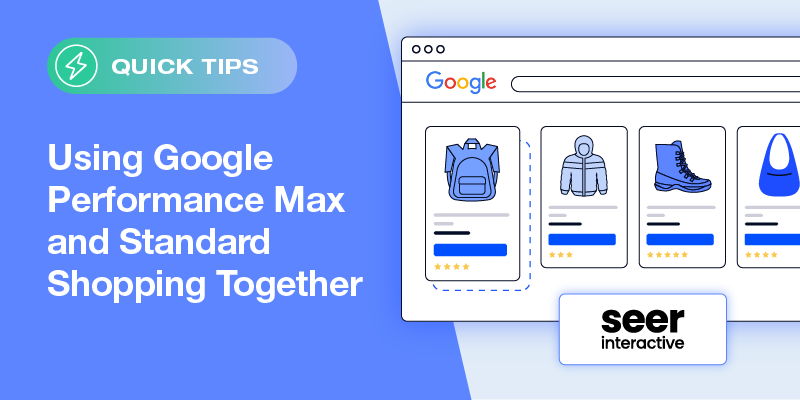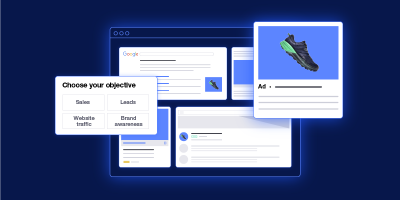At Seer Interactive, we heavily incorporate testing and data-driven approaches into our strategy. With the transition from Google Smart Shopping campaigns to Performance Max in 2022, we sought to find a new balance of automation and control. Thus, the team introduced complementary Standard Shopping campaigns alongside Performance Max.
Google has not released updates detailing when Standard Shopping campaigns will sunset. However, it is likely a matter of time, rather than an “if.” Listed below are two Standard Shopping campaign tests that were valuable for our clients and that we think can be valuable for other brands while this campaign type is still available.
Spillover Standard Shopping Campaign
The goal of this Google Shopping campaign is to saturate as much demand as possible for top-performing products. We created a Standard Shopping campaign for these products and didn’t exclude them from Performance Max.
We utilized a custom label in the data feed for easy organization and management. This setup simplifies future adjustments as we calibrate the selected products for shifts in seasonality and inventory. Custom labels are used to filter products into groups by your criteria of choice. You can use them to segment products into various groups based on similar attributes and adjust your bid strategy accordingly.
“At Feedonomics, we typically import performance data from Google Analytics. Then we apply custom labels in the feed to group the top performers, so advertisers can build a campaign for that segment.”
Overall, this campaign has become an important part of our strategy due to its efficiency and ability to scale revenue. The return on ad spend (ROAS) for this campaign outperforms Performance Max and allows for more control. Listed below are some of the concerns, hypotheses, and results associated with this campaign:
1. Trouble serving ads in both campaigns
The consensus across digital marketers and “confirmed” by Google is that “Performance Max will take precedence over Standard Shopping, so if you have the same products in both campaigns, Standard Shopping will not serve ads nor compete against Performance Max.”
However, we prefer to confirm with first-hand tests and our data contradicts these theories. Listed below is a table showing an index of media spend for each campaign by hour of the day.
Hypothesis: The spillover campaign will remain inactive until the Performance Max campaign exhausted its budget.
Results: The hourly spend breakdowns for each campaign are very similar. The spillover campaign even distributed ads in the first hour of the day. Thus, our hypothesis was wrong—the spillover campaign does not require the Performance Max campaign to exhaust its budget in order to serve. The data suggests that these two campaigns can run in tandem.

2. Campaigns competing with each other
Another concern with this setup was that the Standard Shopping campaign would compete with Performance Max. As mentioned earlier, the common stance is that these campaigns will not compete, regardless if products are targeted in both campaign types.
Hypothesis: The spillover campaign will not lead to an increase in cost per click (CPC) for the double-targeted products.
Results: CPC for the group of products reduced by 21% in the Performance Max campaign, while volume metrics increased by 15% period-over-period.
Low-ROAS Campaign
As we found in a previous test, our Performance Max campaigns drive the best results in a consolidated structure. Thus, we did not want to break out the low-performing products into a separate Performance Max campaign. Instead, we removed the products from the Performance Max campaign and included them in a separate Standard Shopping campaign.
Similar to the spillover campaign, we recommend using a custom label in the data feed to organize the selected products. This simplifies the setup and upkeep process of relocating products.
[TIP] It is important to add the product/category pages as URL negatives in the Performance Max campaign if you utilize final URL expansion (recommended).
This campaign resulted in a 20% increase in ROAS for these products compared to this group’s performance within the Performance Max campaign in the prior period.
“In addition to the tips above, you can increase your ROAS by optimizing your product data. Detailed titles and descriptions, paired with granular product categorization and extensively filled-in product attributes, allow your listed products to be matched with more high-intent shoppers.”
In Conclusion
Although Performance Max is an extremely profitable campaign type, there is still opportunity for Standard Shopping campaigns. These are just two testing opportunities; there are many more ways to structure profitable shopping campaigns. If you want to learn about similar testing opportunities in the future, sign up for Seer Interactive’s newsletter.

Kurtis Nysmith is a Paid Media Account Manager at Seer Interactive. He focuses on improving ROI and scalability through continuous testing and creative solutions.





